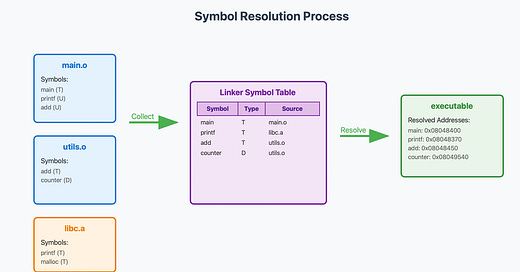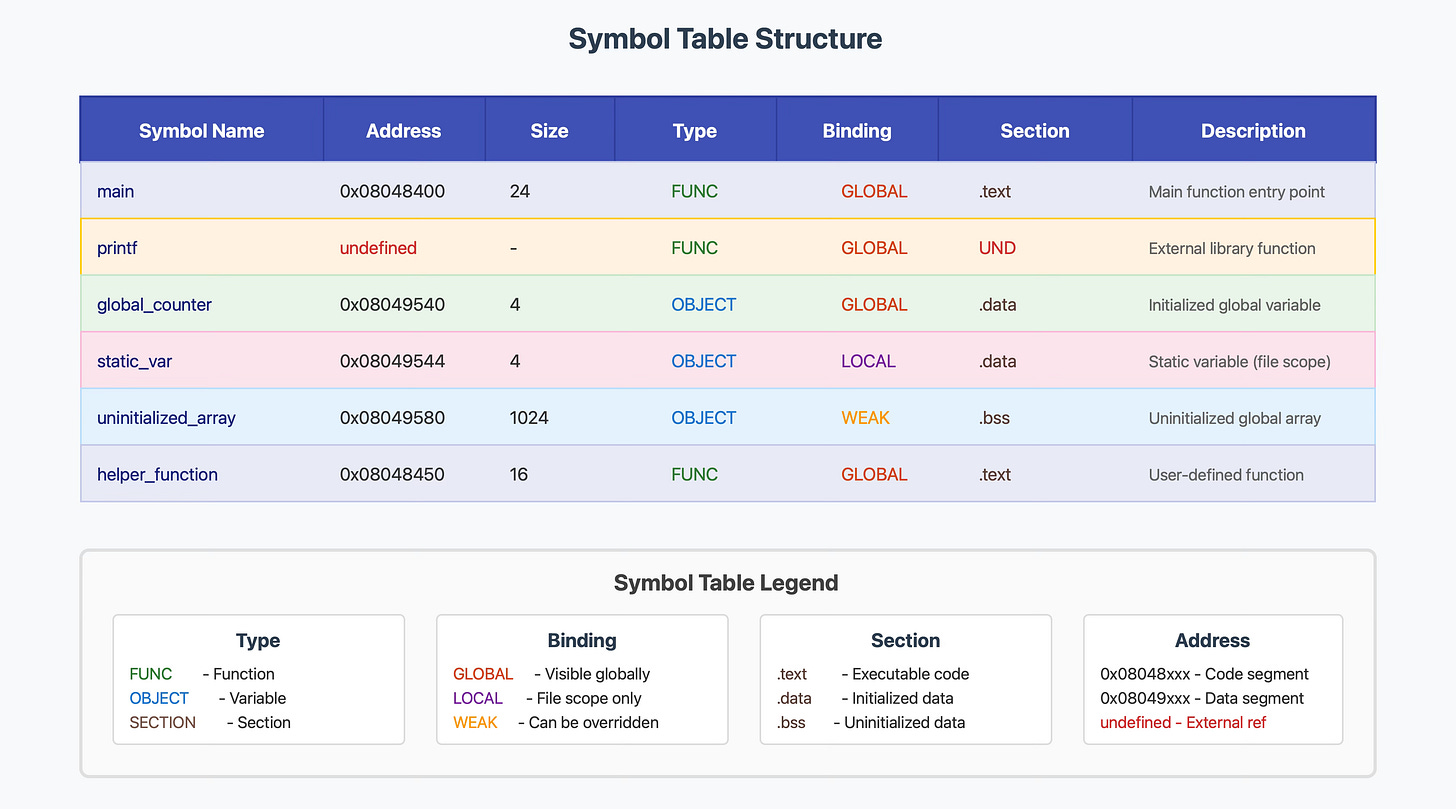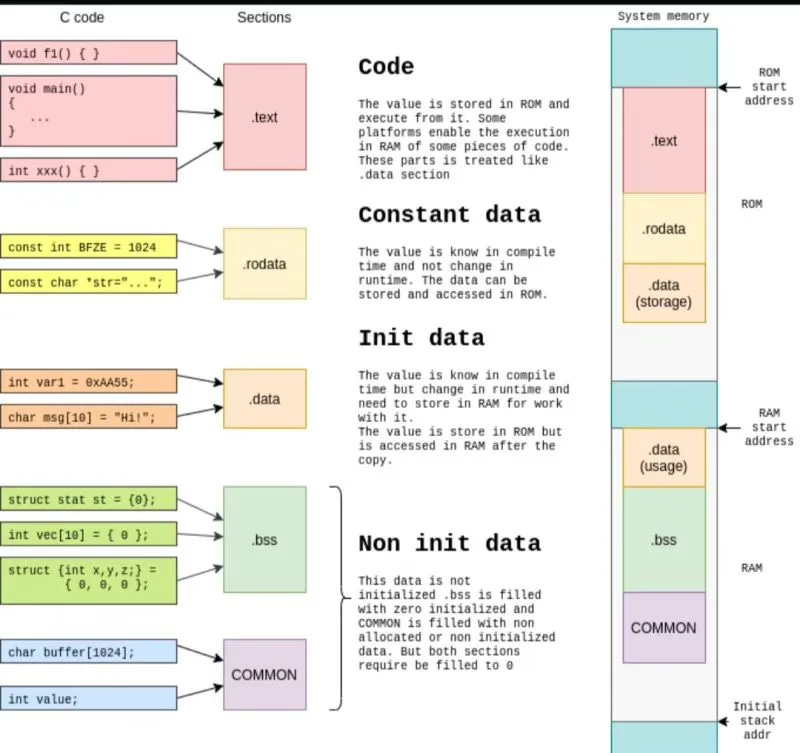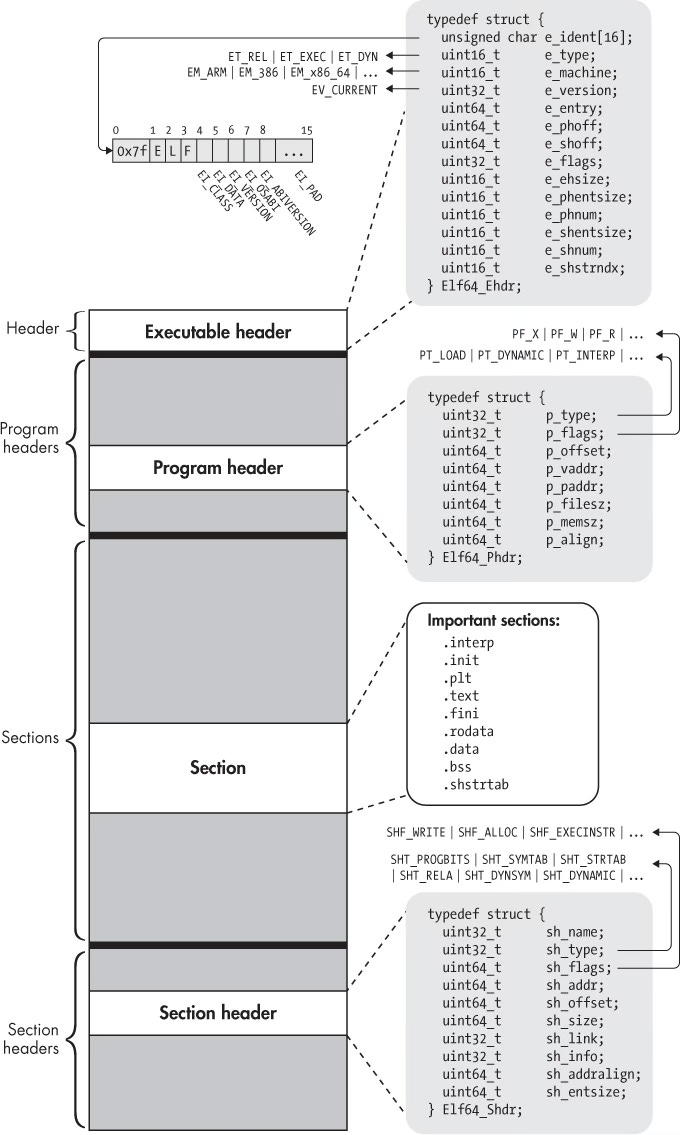The Linker's Detective Work: How Symbol Resolution Turns Code Fragments Into Running Programs
Understanding the intricate process that connects your function calls, variables, and libraries into a cohesive executable
Every time you write printf("Hello, world!"); in C or call a method from another class in C++, you're creating a puzzle piece that needs to fit perfectly with thousands of other pieces. The linker is the detective that solves this massive jigsaw puzzle, figuring out where every function lives, which variable belongs to whom, and how to wire everything together into a program that actually runs.
I've spent countless hours debugging linker errors—those cryptic "undefined reference" messages that make you question your life choices. Trust me, understanding how symbol resolution works will save you from many of those late-night debugging sessions.
What Are Symbols, Really?
Before we can understand how linkers resolve symbols, we need to be clear about what symbols actually are. In the simplest terms, a symbol is any named entity in your program that the linker needs to keep track of. This includes:
Functions (
main,printf,malloc)Global variables (
extern int counter)Static variables (those marked with
static)Class methods (in C++, these become mangled function names)
Think of symbols as labels attached to specific memory locations. When you write int global_counter = 42; at the top of your C file, you're creating a symbol called global_counter that points to a specific spot in memory where the value 42 lives.
Here's where it gets interesting: symbols aren't just about your code. When you call printf, you're referencing a symbol that lives in the C standard library. Your compiled object file contains a note saying "I need something called printf, but I don't know where it is yet." The linker's job is to find that printf function and wire up your call to point to the right place.
The Compilation Pipeline: Where Symbols Come From
To understand symbol resolution, you need to see the bigger picture of how source code becomes a running program. The process looks something like this:
Preprocessing: The preprocessor handles
#includeand#definestatementsCompilation: The compiler turns C/C++ code into assembly language
Assembly: The assembler converts assembly into object files (.o or .obj)
Linking: The linker combines object files and libraries into an executable
Symbol resolution happens during that final linking step, but the groundwork is laid earlier. When the compiler processes your source file, it creates a symbol table—essentially a list of all the names it encountered and what it knows about them.
Let's look at a simple example:
// file1.c
int shared_variable = 100;
void print_message() {
printf("Hello from file1\n");
}// file2.c
extern int shared_variable;
extern void print_message();
int main() {
printf("Shared variable: %d\n", shared_variable);
print_message();
return 0;
}When you compile file1.c, the compiler creates an object file that defines two symbols: shared_variable and print_message. When you compile file2.c, it creates an object file that references these symbols (marked as extern) but doesn't define them. It also references printf, which isn't defined in either file.
The linker's job is to match up these references with their definitions and figure out where everything should live in the final executable.
Symbol Types: Strong vs. Weak
Not all symbols are created equal. The linker categorizes symbols into two types that affect how conflicts are resolved:
Strong symbols include:
Functions that are defined (have a body)
Initialized global variables
Weak symbols include:
Uninitialized global variables
Function declarations without definitions
This distinction matters when the linker encounters multiple definitions of the same symbol. Here are the rules it follows:
Multiple strong symbols with the same name: Error! The linker refuses to continue.
One strong symbol, one or more weak symbols: The strong symbol wins.
Multiple weak symbols: The linker picks one arbitrarily (and this can lead to bugs).
I learned this the hard way when I accidentally declared the same global variable in two different files. The program compiled and linked just fine, but weird things started happening at runtime because both files were fighting over the same memory location.
The Symbol Table: A Linker's Phonebook
Every object file contains a symbol table—think of it as a phonebook that lists every symbol the file knows about. You can actually peek at this table using tools like nm on Unix systems or dumpbin on Windows.
Try this experiment:
# Compile a simple C file
gcc -c example.c -o example.o
# Look at the symbol table
nm example.o
You'll see output that looks something like this:
0000000000000000 T main
U printf
0000000000000004 D global_var
The letters tell you what kind of symbol each one is:
Tmeans it's defined in the text (code) sectionUmeans it's undefined (referenced but not defined here)Dmeans it's defined in the data section
The numbers are addresses, but they're not final addresses yet—that's what the linker will figure out.
Symbol Resolution in Action
Let's walk through what happens when you link multiple object files together. The linker goes through each file and builds a comprehensive picture of all the symbols it needs to deal with.
Step 1: Collect References and Definitions
The linker scans through all the object files and libraries you've specified, building two lists:
Symbols that are referenced but not defined
Symbols that are defined
Step 2: Match References to Definitions
For each undefined symbol, the linker searches through all the definitions it has collected. If it finds exactly one definition, great! If it finds zero definitions, that's an "undefined reference" error. If it finds multiple definitions, it applies the strong/weak rules.
Step 3: Handle Special Cases
Some symbols require special handling:
Common symbols: Uninitialized global variables that might be defined in multiple files
Static symbols: These have local scope and don't participate in global symbol resolution
Library symbols: These are only pulled in if they're actually needed
The ELF File Format: Where Symbols Live
On Unix-like systems, object files and executables use the ELF (Executable and Linkable Format) format. Understanding ELF structure helps demystify what the linker is actually doing.
An ELF file is divided into sections:
.text: The actual machine code.data: Initialized global variables.bss: Uninitialized global variables (Better Save Space—they don't take up file space).symtab: The symbol table.rel.textand.rel.data: Relocation entries
The symbol table entries contain:
Symbol name (actually an index into a string table)
Value (usually an address)
Size
Type (function, variable, etc.)
Binding (local, global, weak)
Section (which section it belongs to)
Relocation: The Final Piece of the Puzzle
Symbol resolution tells the linker which symbols go with which definitions, but there's still one crucial step: relocation. This is where the linker patches up all the addresses in your code.
When the compiler generates machine code, it doesn't know where functions and variables will end up in the final executable. So it leaves placeholders that essentially say "put the address of printf here" or "put the address of global_variable here."
Here's a simplified example of what this looks like in assembly:
# Before linking
call printf # This is actually "call <placeholder>"
mov eax, [global_var] # This is "mov eax, [<placeholder>]"
# After linking
call 0x08048370 # Actual address of printf
mov eax, [0x08049540] # Actual address of global_varThe linker maintains relocation tables that tell it exactly where these placeholders are and what they should be replaced with.
Common Symbol Resolution Problems
Undefined References
This is probably the most common linker error you'll encounter:
undefined reference to `function_name'Common causes:
Forgot to link a required library
Misspelled a function name
Forgot to compile and link a source file
Function is declared but never defined
Multiple Definitions
multiple definition of `symbol_name'This happens when you have strong symbols with the same name in different object files. Usually caused by:
Defining a function in a header file that's included multiple times
Accidentally defining the same global variable in multiple files
Link Order Matters
Here's something that trips up many programmers: the order of files and libraries on the command line matters. The linker processes files left to right, and it only pulls in library symbols that are needed to resolve undefined references it has already seen.
# This might fail
gcc -lmath main.o # libmath is processed before main.o
# This should work
gcc main.o -lmath # main.o is processed first, creating references that libmath can satisfyLanguage-Specific Symbol Resolution
Different programming languages handle symbol resolution in their own ways:
C++
C++ adds complexity with name mangling. When you write a function like:
void print(int x) { }
void print(double x) { }The compiler generates mangled names that encode the parameter types, something like _Z5printi and _Z5printd. This allows function overloading to work at the linker level.
Dynamic Languages
Languages like Python and JavaScript handle symbol resolution at runtime rather than link time. When you write import math in Python, the symbol resolution happens when the program runs, not when it's compiled.
Java and C#
These languages use virtual machines that handle their own form of symbol resolution. The JVM and .NET runtime load classes and resolve method calls dynamically.
Modern Linking: Shared Libraries and Dynamic Loading
Traditional linking creates static executables where everything is bundled together. Modern systems also support dynamic linking, where symbol resolution happens at runtime.
With shared libraries (.so files on Unix, .dll files on Windows), some symbols aren't resolved until the program actually runs. This is why you might get a runtime error about a missing shared library even though your program compiled and linked successfully.
The dynamic linker (usually ld.so on Linux) handles this runtime symbol resolution using techniques like:
Lazy binding: Function addresses are resolved only when first called
Global symbol interposition: Symbols in the main program can override library symbols
Debugging Symbol Resolution Issues
When things go wrong, here are some tools that can help:
nm: Lists symbols in object files
nm -u program.o # Show undefined symbols
nm -D program # Show dynamic symbolsobjdump: Disassembles object files and shows relocation info
objdump -t program.o # Show symbol table
objdump -r program.o # Show relocation entriesldd: Shows shared library dependencies
ldd program # List dynamic dependenciesreadelf: Detailed ELF file analysis
readelf -s program.o # Symbol table
readelf -r program.o # Relocation entriesPerformance Considerations
Symbol resolution can be a bottleneck for large programs. Some strategies to improve link times:
Minimize Symbol Visibility
Use static for functions and variables that don't need to be visible outside their compilation unit. This reduces the number of symbols the linker needs to process.
Avoid Header-Only Libraries
While convenient, header-only libraries can lead to code bloat and slow link times because the same code gets compiled into multiple object files.
Use Link-Time Optimization (LTO)
Modern compilers can optimize across compilation units during linking, but this makes the linking process slower while potentially making the final program faster.
The Future of Linking
Linking technology continues to evolve:
Incremental Linking: Only re-link the parts that changed, speeding up development cycles.
Parallel Linking: Modern linkers can resolve symbols and perform relocations in parallel.
LTO and Whole-Program Optimization: Blurring the line between compilation and linking to enable better optimizations.
Key Takeaways
Symbol resolution is the process by which linkers connect references to definitions across multiple object files and libraries. The key points to remember:
Symbols are named entities (functions, variables) that need addresses in the final executable
The linker follows specific rules to resolve conflicts between multiple symbol definitions
Strong symbols (initialized variables, function definitions) take precedence over weak symbols
The order of files and libraries on the command line can affect linking success
Modern systems support both static and dynamic symbol resolution
Understanding symbol resolution helps debug common linking errors
Practical Exercises
Exercise 1: Symbol Table Exploration
Create a simple C program with multiple files:
// math_utils.c
int add(int a, int b) {
return a + b;
}
int global_counter = 0;// main.c
#include <stdio.h>
extern int add(int a, int b);
extern int global_counter;
int main() {
printf("Result: %d\n", add(5, 3));
global_counter++;
return 0;
}Compile each file separately and use nm to examine the symbol tables. Then link them together and see how the symbols are resolved.
Exercise 2: Debugging Undefined References
Intentionally break the linking process by:
Commenting out the definition of
addin math_utils.cMisspelling a function name
Forgetting to link the math_utils.o file
Practice reading and understanding the linker error messages.
Exercise 3: Strong vs. Weak Symbols
Create two files that define the same global variable and experiment with initialized vs. uninitialized versions. Observe how the linker handles conflicts.
Exercise 4: Library Linking Order
Create a program that uses a mathematical function from libm (like sin or cos). Experiment with different orders of -lmon the command line to see when linking succeeds or fails.
References and Further Reading
ELF Specification: The official standard for the Executable and Linkable Format
GNU ld Documentation: Comprehensive guide to the GNU linker
"Linkers and Loaders" by John Levine: Classic book on linking technology
System V ABI: Application Binary Interface standards that define symbol resolution rules
Understanding symbol resolution transforms linking from mysterious black magic into a logical, debuggable process. The next time you see an "undefined reference" error, you'll know exactly where to start looking. And when you're designing large software systems, you'll appreciate how thoughtful symbol organization can make builds faster and more reliable.
The linker might work behind the scenes, but its detective work in resolving symbols is what makes modern software development possible. Every time your program runs successfully, it's a testament to the linker's ability to solve the complex puzzle of connecting thousands of code fragments into a cohesive whole.







